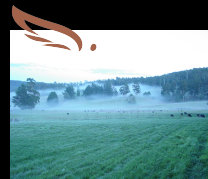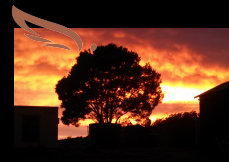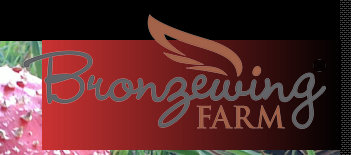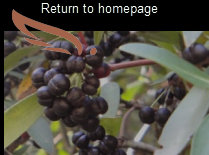

Copyright 2011 - 2024
What's in a name? The property has been called 'Bronzewing Farm' for as long as our records are able to show. The 'Bronzewing' in
question is the brush bronzewing pigeon (Phaps elegans) which is often heard calling from the bush, or perhaps the brush, throughout
the day.
However, the bronzewing is only one of many birds, other animals, and plants found on the property. Forty species of bird have so far been identified including Richard's Pippits and Brown Quail which occupy the pastures, and swamp harriers and wedge-tailed eagles which dominate the sky.
Five species of frog, 2 species of lizard and a few copperhead snakes are commonly encountered (see our video of a copperhead snake being rescued from the bird-netting covering the Mountain Peppers in 2017). Platypus are found each year swimming in the farm dams (see our video from 2018). Bandicoots live in all the long grass and sedge areas that have been fenced to exclude the cattle. These areas are fenced with plain wire electric fencing which cattle will not attempt to pass through, but allows full movement in and out for smaller native animals. Pademelons and Bennett's Wallabies are common in the bush around the farm but we are trying to limit their visitation rights.
Nature and agriculture seem to fit seamlessly together on Bronzewing Farm. The photo on the right is of a Tasmanian Mountain Pepper bush (Tasmannia lanceolata) growing out of the side of one of the giant Tree Ferns (Dicksonia antarctica) growing in the farm's gullies.
However, the bronzewing is only one of many birds, other animals, and plants found on the property. Forty species of bird have so far been identified including Richard's Pippits and Brown Quail which occupy the pastures, and swamp harriers and wedge-tailed eagles which dominate the sky.
Five species of frog, 2 species of lizard and a few copperhead snakes are commonly encountered (see our video of a copperhead snake being rescued from the bird-netting covering the Mountain Peppers in 2017). Platypus are found each year swimming in the farm dams (see our video from 2018). Bandicoots live in all the long grass and sedge areas that have been fenced to exclude the cattle. These areas are fenced with plain wire electric fencing which cattle will not attempt to pass through, but allows full movement in and out for smaller native animals. Pademelons and Bennett's Wallabies are common in the bush around the farm but we are trying to limit their visitation rights.
Nature and agriculture seem to fit seamlessly together on Bronzewing Farm. The photo on the right is of a Tasmanian Mountain Pepper bush (Tasmannia lanceolata) growing out of the side of one of the giant Tree Ferns (Dicksonia antarctica) growing in the farm's gullies.
Above: Tasmanian Mountain Pepper bush growing out the side of a Tree Fern.
(click image to enlarge)
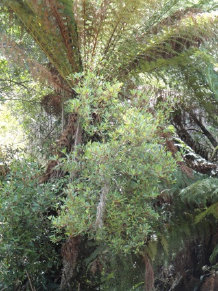
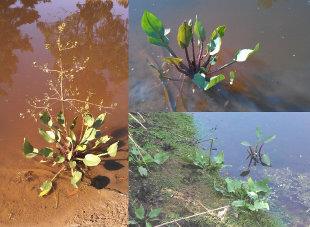
In 2013 we discovered 12 of the "rare" starfruit plant in one of our farm dams, and the plants have been growing there since.
The Tasmanian government website (www.threatenedspecieslink.tas.gov.au) lists the plant as rare because it is only known from three
locations. The nearest of these locations to our farm is 30 km away in the Launceston area. We had several of the farm's
dams dredged of decades worth of silt in the winter of 2012 and it is likely that seeds of the plant were uncovered in the process.
Left: Starfruit plants (Damasonium minus) in one of our farm dams.
(click image to enlarge)
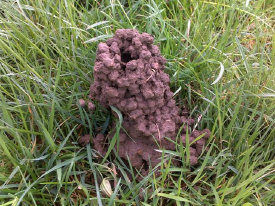
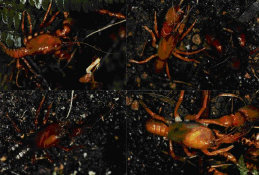
For more than 5 years we have seen the 'chimneys' of Tasmanian Burrowing Crayfish (see photo below). Hopefully it is the
Mt. Arthur Burrowing Crayfish (Engaeus orramakunna), given we are at the foot of Mt. Arthur. E. orramakunna is a 'threatened
species' because of its' limited distribution. A brochure on the genus is available here Burrowing crayfish brochure.
The photos of the crayfish below are from a study on the distribution and abundance of the species by Doran & Richards 1996.
Above: "Chimneys" of the Mt. Arthur Burrowing Crayfish.
(click image to enlarge)
Above: Tasmanian Burrowing Crayfish (photo from Doran & Richards, 1996).
(click image to enlarge)
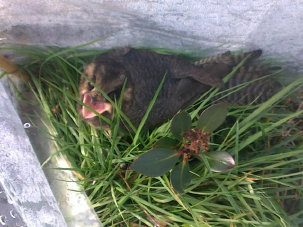
Another really neat finding was that of the Australian Owlet Nightjar (Aegotheles cristatus). The bird in the picture below
must have been out feeding on insects and flown into the plastic sleave protectors around the new mountain pepper trees in 2011, and
was then unable to fly out. I had never seen a Nightjar before and first thought it must have been a baby bird, but after checking
to make sure it's wings were OK, I held it up high on my hands and it flew off strongly to the bush.
Left: The Australian Owlet Nightjar getting up close and personal with Tasmanian Mountain Pepper.
(click image to enlarge)
